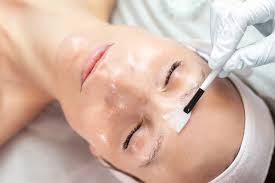
How Chemical Exfoliation Works To Perfect Your Skin
Chemical exfoliation may sound scary, but it has made its way into almost everyone’s skincare routine one way or another. You’ve no doubt heard beauty experts express their love for chemical exfoliating products which include AHAs and BHAs to help deliver outstanding results, but what exactly are they and how do they differ to manual face scrubs. Let’s dive in to find out more about chemical exfoliation.
What is a chemical exfoliant?
Chemical exfoliants are acids that react with the skin once they are applied. They have the ability to remove the build-up of dead skin cells, excess sebum and dirt that can lead to breakouts and the complexion becoming dull and lacklustre.
These exfoliants vary from physical scrubs because you do not need to add any pressure or movements to get the product working. Many believe that using chemical rather than manual exfoliation gives you a more uniform set of results without being too harsh on the skin.
How do chemical exfoliants work?
Once a chemical exfoliant is applied, the acid works its way down into the layers of the skin and works hard at dissolving the “glue” of dead skin cells. Once the bounds are gone the dead cells are removed easily revealing a fresh, healthy layer of skin underneath.
It is typically Alpha Hydroxy Acids, or AHAS, that work on the outer layer of the skin helping to restore a glow back. By doing this they are removing the chances of dead skin cells building up causing breakouts, fine lines and wrinkles and dry patches to the skin. With Beta Hydroxy Acids, BHAs, you will find work further down into the lower layers of the skin and are able to slough away dead skin cells and clear out any bacteria, trapped dirt and excess sebum from blocked pores that later become blemishes, such as blackheads, spots and cysts.
This may indeed sound a little daunting at first, especially with the thought of using acid on your face, but the quantities are controlled to ensure that you will see great results. There are a number of acids available which can become confusing and you must proceed with caution to make sure you’re using the best acid you and your skin will love.
What chemical exfoliants acid should I use?
There’s no denying you are spoilt for choice when it comes to chemical exfoliants. There is an acid out there that will suit almost all skin types. Here is a rundown of the most popular and loved acids on the market, you will find that many products contain at least one of these acids.
Glycolic Acid- This acid is great for normal to oily skin types, it is able to exfoliant the skin and clear out clogged pores making them appear smaller and less visible. You will find this acid in face washes, toners and serums and give the skin a more even texture.
Malic Acid- This acid will revive dull-looking skin by buffing away dead skin cells to reveal a wonderfully healthy, mega-watt glow! This AHA is the lesser-known of the group but still likely to be found in face washes, serums and face masks.
Lactic Acid- This acid is more gentle and great to use for dry skin types. Flaky patches are wiped away and hydration is locked into thirsty skin giving an all-over smooth and nourished finish.
Salicylic Acid- This acid works the furthest down in the skin and can unclog pores and shift away dirt and debris with no problem making it a fail-safe for blemish-prone and oily skin. You will find this BHA in all many of products, from serums to masks and toners.
To make sure you have chosen the best acid for your skin always perform a patch test for 24 hours, apply a pea-size amount of the product either on your forearms or behind your ear, keeping a close eye for any skin irritation or reactions. If you are still unsure then seek the help from a dermatologist.
How to use a chemical exfoliant?
This all depends on what product your chemical exfoliant is formulated into. You must always keep in mind that too much exfoliation of the skin will create some issues if you notice your skin has become dry, tight and uncomfortable than you may unknowingly be using too many products containing acids, or you are over-using them.
Face Wash
The concentrates of the acids in a face wash are lower allowing you to cleanse your skin twice daily. You will find a marked improvement, especially with how squeaky clean you feel when using a chemical exfoliating face wash compared to other washes.
Toner
The acid levels are usually higher in toners so how many times a week you use them is down to you and the skin type you have. Begin with 3 times a week and see how your skin reacts and feels. If you feel as though you need a little extra than increase the usage, if you are feeling dry and tight, decrease the usage.
Serums
Serums are tricky to determine as the concentrates vary a lot from brand to brand. Some advise on nightly application, while others suggest less. Check the ingredients and instructions that come with the product to make sure you are using them correctly.
Face Masks
It’s best to only use a face mask at a maximum of 3 times a week, any more will result in skin irritation and an uncomfortably tight face.
Those are the most popular products found to contain chemical exfoliating properties, as previously mentioned if you are adding a new product to your routine make sure it is safe and the right one for your skin.
Can I use a face mask after a chemical exfoliant?
It depends on what ingredients are in the formula of the face mask, try avoiding any that contain facial acids and other potentially harsh compounds. If you are wanting to use a face mask after because your skin is feeling tight, or perhaps stinging than it is best to leave the skin bare for about 20 minutes, this will give your face enough time to rebalance the oil and water levels in your skin’s barrier. Applying water-based hydrating moisturisers will help calm the skin after using over the counter products, however, if it is a chemical peel you have had than following the advice of your consultant will very important.
Can I use chemical exfoliants under the eyes?
Not really, the skin around the eye area is very thin in comparison to the rest of your face, this is why the first signs of ageing usually start around the eyes. Any harsh acids under the eyes will cause a lot of problems and can potentially make the eyes extremely sore. There are only a couple of acids you can use around the eyes safely without any worry of irritation. Small amounts of glycolic will help with cell turn over helping with dark circles and hyaluronic acid (which isn’t the same as the other acids) to give the eye area a supercharged hydration boost.
How quick can you see the effects of chemical exfoliants?
The results vary from person to person, for some it can be after the first week, or others minutes after use!
With their ability to buff away the layer of dead skin you may find that your skin has come back to life looking more youthful, plumper and hydrated. Consistency is key and if you continue to use chemical exfoliation in your skincare routine overtime skin concerns such as blemishes and a dull complexion could become a distant memory. Other concerns, such as fine lines and wrinkles will start becoming less prominent after roughly 4 weeks.
Just keep in mind to not overdo it and let the chemical do all the hard work.
What are the dos and don’ts of using chemical exfoliants?
The Dos
Do find the best product for your skin that contains a chemical exfoliant
Do use it when instructed allowing you to see results quicker
Do consult a dermatologist if you have any concerns
Do apply an SPF every day to keep your newly exfoliated skin safe in the sun
Do use chemical exfoliant to tackle blemishes and spots
Do use chemical exfoliants to restore the glow back to a dull complexion
Do use regularly to see results in the reduction of fine line and wrinkles
The Don’ts
Don’t use harsh and abrasive clothes when you are using a chemical exfoliant
Don’t use a chemical exfoliant on broken skin
Don’t use a manual face scrub before or after chemical exfoliants
Don’t use until you have performed a 24-hour patch test
Don’t overuse the exfoliants as this can cause dryness and skin irritation
Don’t use on sensitive skin without consulting a GP or dermatologist
Don’t apply strong exfoliants around the eye area
Hopefully, now you have a better understanding of what a chemical exfoliant is and how you can incorporate it into your daily skincare routine. If you have any queries and want to know more about the acids mentioned then please check out our dedicated AHAs and BHAs guide.
Don’t miss out on more skincare tips and expert advice over on our YouTube channel! Come and find us on The Green Sofa by hitting the subscribe button, you won’t regret it!


